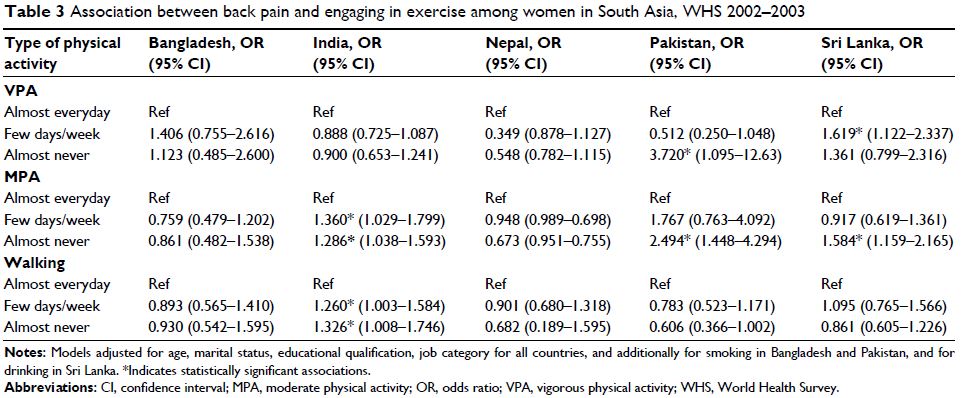108384
论文已发表
注册即可获取德孚的最新动态
IF 收录期刊
- 3.4 Breast Cancer (Dove Med Press)
- 3.2 Clin Epidemiol
- 2.6 Cancer Manag Res
- 2.9 Infect Drug Resist
- 3.7 Clin Interv Aging
- 5.1 Drug Des Dev Ther
- 3.1 Int J Chronic Obstr
- 6.6 Int J Nanomed
- 2.6 Int J Women's Health
- 2.9 Neuropsych Dis Treat
- 2.8 OncoTargets Ther
- 2.0 Patient Prefer Adher
- 2.2 Ther Clin Risk Manag
- 2.5 J Pain Res
- 3.0 Diabet Metab Synd Ob
- 3.2 Psychol Res Behav Ma
- 3.4 Nat Sci Sleep
- 1.8 Pharmgenomics Pers Med
- 2.0 Risk Manag Healthc Policy
- 4.1 J Inflamm Res
- 2.0 Int J Gen Med
- 3.4 J Hepatocell Carcinoma
- 3.0 J Asthma Allergy
- 2.2 Clin Cosmet Investig Dermatol
- 2.4 J Multidiscip Healthc

南亚老年人参与体力活动和背痛的关系
Authors Bishwajit G, Tang S, Yaya S, Feng Z
Received 23 January 2017
Accepted for publication 4 March 2017
Published 15 April 2017 Volume 2017:10 Pages 905—913
DOI https://doi.org/10.2147/JPR.S133013
Checked for plagiarism Yes
Review by Single-blind
Peer reviewers approved by Dr Colin Mak
Peer reviewer comments 2
Editor who approved publication: Dr E. Alfonso Romero-Sandoval
Introduction: Globally, chronic back pain is one of the most commonly encountered
medical conditions among an elderly population with significant bearings on
health, functional mobility and general well-being.
Objective: To estimate the burden of chronic back pain and its association with
physical activity (PA) among population aged 50 years and above in Bangladesh,
India, Nepal, Pakistan and Sri Lanka.
Methods: Cross-sectional data on 8502 men and women aged 50 years and above were
collected from the World Health Survey (2002). Three forms of PA were
considered – vigorous physical activity (VPA), moderate physical activity (MPA)
and walking. Odds ratios (ORs) of the association between self-reported back
pain and VPA, MPA and walking were calculated by using generalized estimating
equations.
Results: The prevalence of back pain was, respectively, 64.8%, 19.8%, 69.5%,
40.6% and 36.2% in Bangladesh, India, Nepal, Pakistan and Sri Lanka. No
significant association between back pain and VPA was observed among men in any
of the countries. In India, Pakistan and Sri Lanka, the odds of suffering from
back pain were, respectively, 29%, 2.5 times and 59% higher among women who
almost never took MPA. In India, taking MPA for few days a week and almost
never was associated with, respectively, 38% (OR=1.38; 95% confidence interval
[CI]=1.017–1.876) and 56% (OR=1.564; 95% CI=1.003–2.438) higher odds of
reporting back pain. Walking almost never was also associated with,
respectively, 83% (OR=1.829; 95% CI=1.14–2.934) and 2.9 times (OR=2.854; 95%
CI=1.419–5.738) higher odds of reporting back pain among men in Nepal and
Pakistan, respectively.
Conclusion: Though the relationship was not consistent across sex and countries,
results indicate that inadequate or nonparticipation can substantially increase
the likelihood of suffering from back pain among an elderly population in this
region. Further research is needed to better understand this relationship and
the potential of exercised-based strategies to prevent and treat back pain
among elderly persons.
Keywords: back pain, older people, physical activity, South Asia, world health
survey
